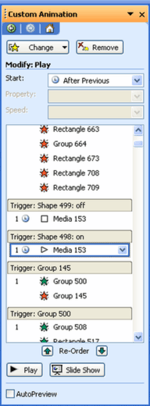PowerPoint animation
PowerPoint animation is a form of animation which uses Microsoft PowerPoint and similar programs to create a game or movie. The artwork is generally created using PowerPoint's AutoShape features, and then animated slide-by-slide or by using Custom Animation. These animations can then be shared by transferring the PowerPoint file they were created in, and can be viewed with PowerPoint or Microsoft's free PowerPoint Viewer and are often exported to video formats such as MP4.

Custom Animation
Custom Animation is a set of effects which can be applied to objects in PowerPoint so that they will animate in the Slide Show . They can be added under the Custom Animation function or through the use of Visual Basic for Applications (VBA). PowerPoint 2000 and earlier versions introduced basic effects such as Appear, Dissolve, Fly In and so forth. In PowerPoint 2002/XP and later versions, the Custom Animation feature was improved, adding new animation effects grouped into four categories: Entrance, Emphasis, Exit, and Motion Paths. The effects were later modified in PowerPoint 2010.
Transitions are effects similar to Custom Animation, but are different in that they can only be applied singularly to individual slides as they change from one slide to another and are limited in options. More slide transitions were added to the selection in PowerPoint 2010.
Entrance effects can be set to objects so that they enter with animations during Slide Show. Emphasis effects animate the objects on the spot. Exit effects allow objects to leave the Slide Show with animations. Motion Paths allow objects to move around the Slide Show. Each effect contains variables such as start (On click, With previous, After previous), delay, speed, repeat and trigger. This makes animations more flexible and interactive, similar to Adobe Flash.
Animation Trigger
Animation Trigger is another feature introduced in Microsoft PowerPoint 2002/XP and the later versions (but, only supported on Macintosh since 2019, in Office 365[1]). This feature allows animators to apply effects that can be triggered when a specific object on the Slide Show is clicked. This feature is the basis for the majority of PowerPoint games, which usually involve clicking object.
Games
Using hyperlinks and Animation Triggers, one can create games such as Jeopardy!, using the tools to maneuver from question to answer. Taking this same principle, the animator can also make more complex games similar to a dungeon game or escape-the-room game. In this format, the animator can create a domain where the player chooses to go right or left, or pick up objects, and so forth. The process takes time, but is generally cheaper and easier than using multimedia software such as Adobe Flash.
For more experienced users, Visual Basic for Applications (VBA) can be used to program animations with more flexibility. [2]
Drawbacks
Though animations can be created easily using Custom Animations provided in Microsoft PowerPoint, it may be much more tedious to complete a project in PowerPoint than in professional animation programs such as Adobe Flash due to the absence of key frames and tweening in the former.
When effects such as Emphasis Grow/Shrink and Spin are applied to objects, they may appear to be jagged or pixelated when previewing in the slide show. In addition, excessive use of these effects may degrade the slide show's performance. PowerPoint's built in Hardware Graphics Acceleration feature does help in minimizing these setbacks, however.[3] Graphics acceleration, though, requires a video card that supports Microsoft Direct3D. Additionally, some animations may appear different when played in older versions of PowerPoint, or not be present at all.
PowerPoint 2000 and later versions introduced macro security to help protect computers from malicious code within a PowerPoint presentation. This led to disabling all VBA or macro code by default, causing presentations containing codes unable to run properly, unless the viewer adjusted their macro security settings to the Low setting.[4] Security Warning in PowerPoint 2007 alerts the user of macros in a presentation as soon as it is opened, giving the option to run the presentation with or without the macros enabled.
PowerPoint is unavailable for Linux and other operating systems, meaning that unlike open-source alternatives such as SVG, animations are not portable across a range of computers or phones.[5][6][7] PowerPoint animations however can be rendered with varying degrees of success through compatible tools such as LibreOffice Impress and Calligra Stage.
References
- "Trigger an animation effect". https://support.office.com/en-us/article/trigger-an-animation-effect-651726d6-9454-4bfd-b8e5-11d84767a6da#OfficeVersion=Mac. External link in
|website=(help); Missing or empty|url=(help) - "Creating Animation Sequences in PowerPoint 2002 and PowerPoint 2003". Microsoft Corporation. Retrieved 2007-03-10.
- "Hardware Graphics Acceleration". Microsoft Corporation. Archived from the original on 2007-05-14. Retrieved 2007-03-10.
- "Macro Security Levels". Microsoft Corporation. Archived from the original on 2007-02-28. Retrieved 2007-03-10.
- "SVG in 3GPP Multimedia Messaging and Streaming Services (version March 2003)". SVG Open. 2003. Retrieved 2009-10-19.
- "3GPP Multimedia Messaging Service (MMS); Media formats and codecs (Release 5); 3GPP TS 26.140 V5.2.0 (2002-12); Technical Specification". 3GPP. 2 January 2003. Archived from the original (zipped doc) on 28 August 2011. Retrieved 25 February 2010.
- "3rd Generation Partnership Project; Technical Specification Group Services and System Aspects; Multimedia Messaging Service (MMS); Media formats and codecs (Release 5)". 3GPP TS 26.140 V5.2.0 (2002-12). 3GPP. March 2003. Archived from the original (zipped doc) on 28 August 2011. Retrieved 24 February 2010.